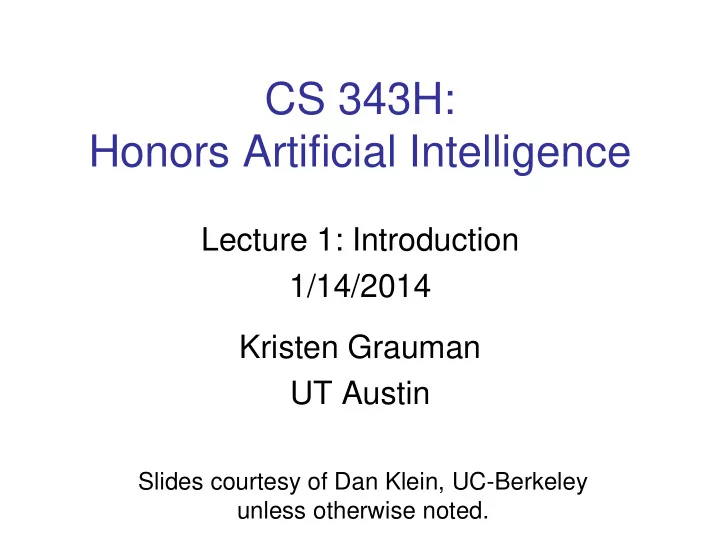

CS 343H: Honors Artificial Intelligence Lecture 1: Introduction 1/14/2014 Kristen Grauman UT Austin Slides courtesy of Dan Klein, UC-Berkeley unless otherwise noted.
Teaching staff Prof. Kristen Grauman TA: Kim Houck
Today What is artificial intelligence? What can AI do? What is this course?
Sci-Fi AI?
Definition Artificial intelligence is… The science of getting computers to do the things they can't do yet? Finding fast algorithms for NP-hard problems? Getting computers to do the things they do in the movies? No generally accepted definition…
Science and engineering AI is one of the great intellectual adventures of the 20 th and 21 st centuries. What is a mind? How can a physical object have a mind? Is a running computer (just) a physical object? Can we build a mind? Can trying to build one teach us what a mind is? Slide credit: Peter Stone
A (Short) History of AI 1940-1950: Early days 1943: McCulloch & Pitts: Boolean circuit model of brain 1950: Turing's “Computing Machinery and Intelligence” 1950 — 70: Excitement: Look, Ma, no hands! 1950s: Early AI programs, including Samuel's checkers program, Newell & Simon's Logic Theorist, Gelernter's Geometry Engine 1956: Dartmouth meeting: “Artificial Intelligence” adopted 1965: Robinson's complete algorithm for logical reasoning 1970 — 90: Knowledge-based approaches 1969 — 79: Early development of knowledge-based systems 1980 — 88: Expert systems industry booms 1988 —93: Expert systems industry busts: “AI Winter” 1990 — : Statistical approaches Resurgence of probability, focus on uncertainty General increase in technical depth Agents and learning systems… “AI Spring”? 2000 — : Where are we now?
Today What is artificial intelligence? What can AI do? What is this course?
What Can AI Do? Quiz: Which of the following can be done at present? Play a decent game of table tennis? Play a decent game of Jeopardy? Drive safely along a curving mountain road? Drive safely along Sixth Street? Buy a week's worth of groceries on the web? Buy a week's worth of groceries at HEB? Discover and prove a new mathematical theorem? Converse successfully with another person for an hour? Perform a complex surgical operation? Put away the dishes and fold the laundry? Translate spoken Chinese into spoken English in real time? Write an intentionally funny story?
Unintentionally Funny Stories One day Joe Bear was hungry. He asked his friend Irving Bird where some honey was. Irving told him there was a beehive in the oak tree. Joe walked to the oak tree. He ate the beehive. The End. Henry Squirrel was thirsty. He walked over to the river bank where his good friend Bill Bird was sitting. Henry slipped and fell in the river. Gravity drowned. The End. [Shank, Tale-Spin System, 1984]
Natural Language Speech technologies Automatic speech recognition (ASR) Text-to-speech synthesis (TTS) Dialog systems Language processing technologies Question answering Machine translation Information extraction Text classification, spam filtering, etc…
Vision (Perception) Reading license plates, zip Face detection codes, checks Reconstructing 3D Instance recognition Slide credit: Kristen Grauman
Vision (Perception) Instance recognition Slide credit: Kristen Grauman
Vision (Perception) Object/image categorization Matthew Zeiler, New York University: http://horatio.cs.nyu.edu/index.html Slide credit: Kristen Grauman
Vision (Perception) Kim et al. 2009 Augmented reality Unusual event detection “wearing red shirt” Shotton et al. 2011 IBM, Feris et al. Pose & tracking Soft biometrics Slide credit: Kristen Grauman
[videos: robotics] Robotics Robotics Part mech. eng. Part AI Reality much harder than simulations! Technologies Vehicles Rescue Soccer! Lots of automation… In this class: We ignore mechanical aspects Methods for planning Methods for control Images from stanfordracing.org, CMU RoboCup, Honda ASIMO sites
Logic Logical systems Theorem provers NASA fault diagnosis Question answering Image from Bart Selman
Game Playing May, '97: Deep Blue vs. Kasparov First match won against world-champion “Intelligent creative” play 200 million board positions per second! Humans understood 99.9 of Deep Blue's moves Can do about the same now with a big PC cluster Open question: How does human cognition deal with the search space explosion of chess? Or: how can humans compete with computers at all?? 1996: Kasparov Beats Deep Blue “I could feel --- I could smell --- a new kind of intelligence across the table.” 1997: Deep Blue Beats Kasparov “Deep Blue hasn't proven anything.” Text from Bart Selman, image from IBM’s Deep Blue pages
Decision Making Applied AI involves many kinds of automation • Scheduling, e.g. airline routing, military • Route planning, e.g. mapquest • Medical diagnosis • Web search engines • Spam classifiers • Automated help desks • Fraud detection • Product recommendations • … Lots more!
Ethics, implications Robust, fully autonomous agents in the real world What happens when we achieve this goal?
Some Hard Questions… Who is liable if a robot driver has an accident? Will machines surpass human intelligence? What will we do with superintelligent machines? Would such machines have conscious existence? Rights? Can human minds exist indefinitely within machines (in principle)?
Today What is artificial intelligence? What can AI do? What is this course?
Goal of this course Learn about Artificial Intelligence Increase your AI literacy Prepare you for topic courses and/or research
Course Topics Part I: Making Decisions Fast search / planning Adversarial and uncertain search Part II: Reasoning under Uncertainty Bayes’ nets Decision theory Machine learning Throughout: Applications Natural language, vision, robotics, games, …
Overview of syllabus Official syllabus is online And see handout
Workload summary Readings due at least once per week Brief written responses for every reading (10%) sent to 343h.readings@gmail.com Class attendance and participation (10%) Assignments (mostly programming) (40%) using Piazza for discussion/questions Midterm (15%) Final (25%)
Course enrollment Course is for honors CS students If you want to enroll but are not registered, please inquire with the CS undergraduate office (first floor of GDC).
Assignments Read the syllabus Join the mailing list (see link online) Enroll on Piazza Reading assignment & email by Wed 8 pm Start first programming assignment – python tutorial (PS0), due 1/23 Complete it independently; no pairs.
Recommend
More recommend